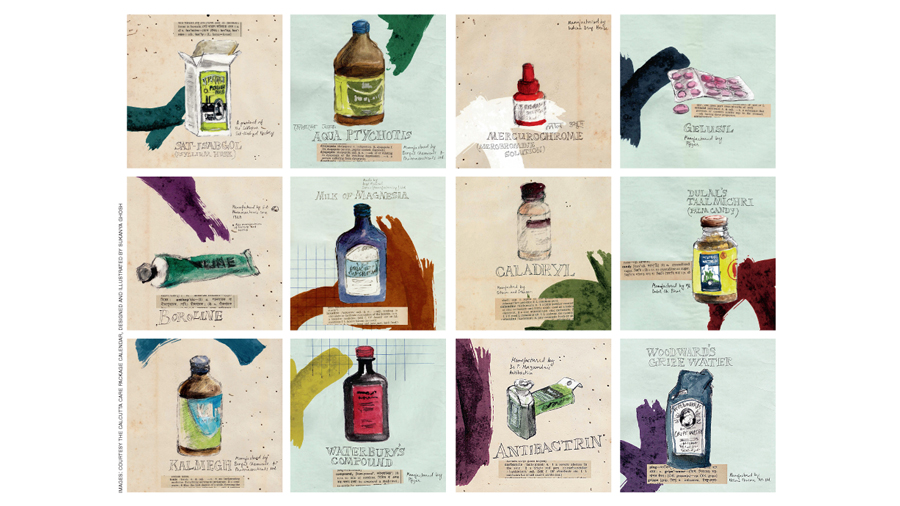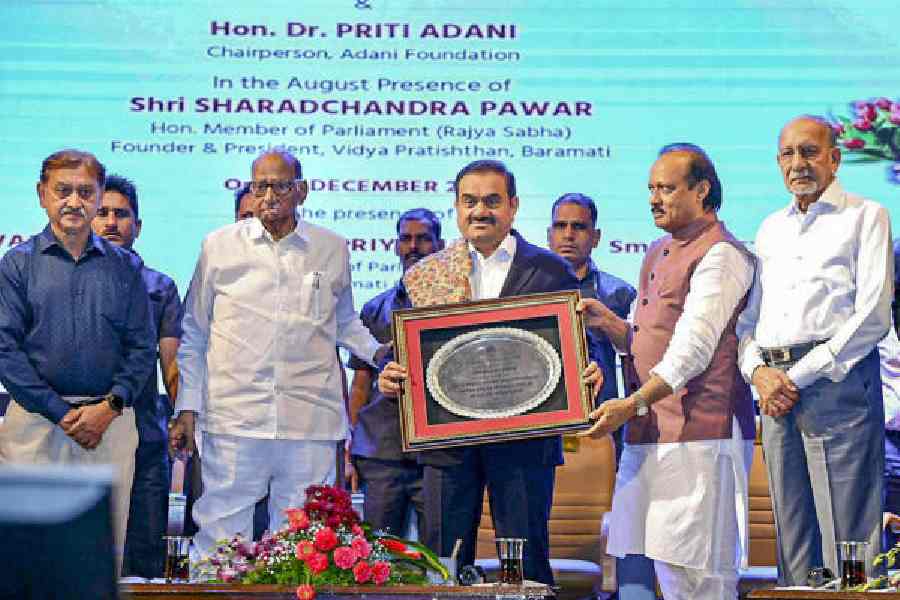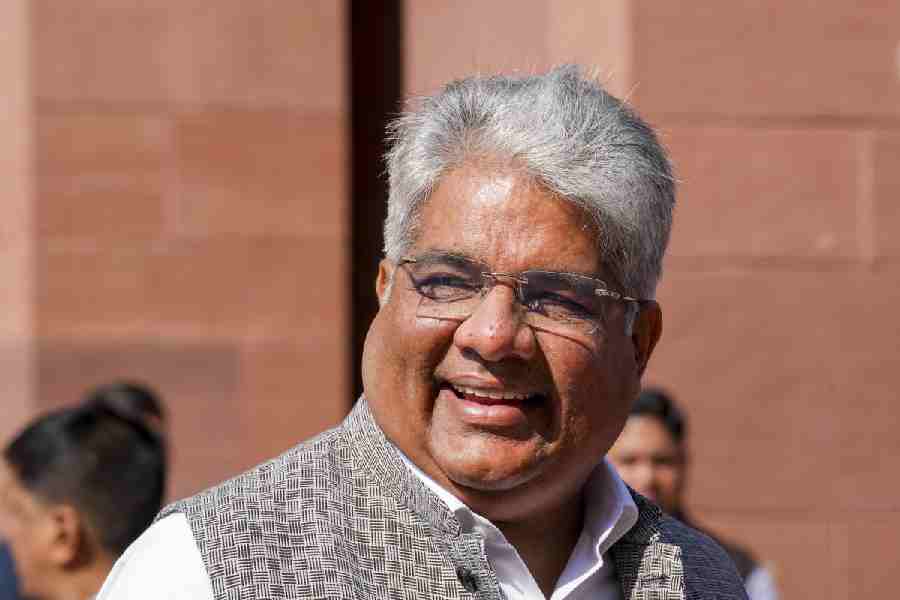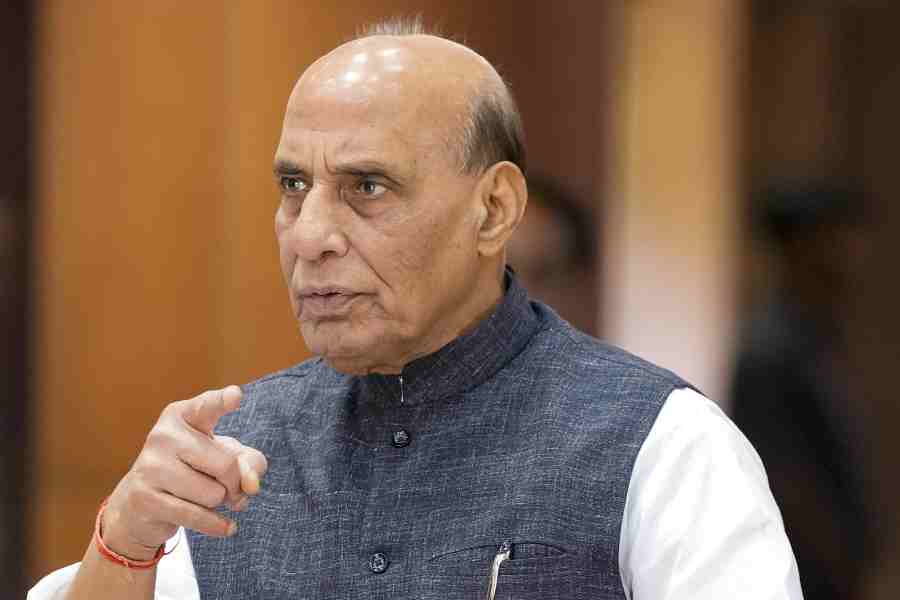Sukanya Ghosh’s The Calcutta Care Package Calendar, created “hurriedly this January”, was not designed for Poila Baisakh, the Bengali New Year. But with a page each on a dozen legacy over-the-counter drugs whose familiarity one cannot escape even if one were to dodge the actual experience of them, the calendar is sure to resonate with many. Ghosh, who studied painting at M.S. University in Baroda and animation at the National Institute of Design in Ahmedabad, says it is meant to be a “healing balm” in the midst of raging health concerns.
Watercolours of Isabgol, Gelusil, Aqua Ptychotis, Dulaler Tal Michhri with legends scribbled across in Bengali and English — you will agree that balm or no, it is a reminder that the Bangali’s calendar year is a continuous exercise in constitutional amendment.
It’s like a memory game. I say Mercurochrome and someone will say “Tincture of Iodine”. I say Tincture of Iodine and Tapan Majumder, former head of department of applied geology at IIT (ISM), Dhanbad, recalls Tincture of Benzoin. “I remember the reddish brown liquid with a strong smell we applied on open wounds,” he says. I say Boroline and he shoots away — “Sloan’s Liniment for sprains; Woodward’s Gripe Water, basically a mix of chuner jol and mourir jol for colicky babies; Gentian Violet for burns and other skin infections; Codopyrin for headaches…” He talks about how he and his colleagues (miners, geologists) would lick quinine sulfate before setting out for fieldwork in the 1960s and how probashi Bangalis living in Patna, Allahabad and Delhi procured several bottles of Kalmegh during their visits home. I have myself scoured Delhi’s Bengali Market eight years ago and drawn blank stares from chemists upon asking for Aqua Ptychotis. In Calcutta you just have to say “jowaner jol/arok” and presto, bottles appear.
Growing up in south Calcutta in the 1960s, Basabi Dasgupta has a memory of her parents’ routine after-dinner conversation. A man of few words, her father would ask her mother: “Tumi koita… How many for you?” He was referring to the number of Milk of Magnesia tablets. Now juxtapose that alongside vascular and endovascular surgeon Ambarish Satwik’s clinical explanation, “Milk of Magnesia is a hyper osmotic laxative, which means it draws water from the gut and gives volume to the faeces and therefore etc.”
With a lot of these products the romance is not in the ingredients but in the times they are tethered to. Almost all of those I interviewed remembered the liquid version of Milk of Magnesia, “a white stuff in a blue bottle” and possessed of digestive properties. It was apparently so popular that family lore has it that when asked what he had had for lunch, an uncle of mine would name a host of things and also add “Magnesia paakhir dudh”. I don’t know what amuses me more about this story, that the little boy believed it was the milk of a bird called Magnesia or that he had come to accept it as part of his diet.
Dasgupta recalls other across-family fixes — jowaner jol after every biyebari… wedding or phuchka session and Entero Quinol. The Locula eyedrop seems to have been omnipresent, the slightest irritation or burning sensation, and you took a drop or two. “It is possible that antiseptic drops or saline drops would cause an astringent reaction,” explains Dr Satwik respectfully. He is equally polite but firm when he points out that the stomachics and digestives could not have cured gastric ulcers. “You now know that peptic ulcers are caused by helicobacter, which is an organism…” he painstakingly continues.
People knew that for a sore throat you had to have Dulaler Tal Michhri or put a lump in water and give it to cranky babies. The moss green Antibactrin with its distinctive smell was for boils. Caladryl for bee stings. When kids scraped knees from climbing trees or took a fall from the cycle, applying Mercurochrome was a given. Another person recalled how till the late 1980s little girls went to school for months with scarlet earlobes — that was Mercurochrome with its antiseptic properties for the newly pierced lobes. Phitkiri or a lump of alum was used as an after-shave; again an antiseptic.
Was any of it what the doctor ordered? Most people I spoke to didn’t seem to remember so. “Amra jantam… We just knew,” was the common response.
Unlike most other communities, Bengalis are not only less suspecting of medicines, they are also particularly embracive of anything medicinal. There is that temptation to put it down to an adventurous and overworked gut, but that cannot be the whole answer.
It is only logical to assume that the other and more credible part of the answer would be — exposure. Majumder had spoken about print advertisements of over-the-counter drugs in the 1960s and 70s. Projit Bihari Mukharji who is associate professor in the department of history and sociology of science, University of Pennsylvania, emails me an image of an 1876 advertisement of Dr E.J. Lazarus’s Essence of Chiretta, touted as “The Great Indian Remedy for all bilious complaints”. The chiretta or chirota’s medicinal properties are legendary, and even now in Bengali households if someone complains of worms, the reflex is to get a couple of sticks of chirota — it is a herb — soak it in water overnight and have the bitter tasting water the next morning. Among Mukharji’s collection there are advertisements for Geler Pachon, a stomachic; a general tonic called Bynum Grapes; the Essence of Bedana; Quinine; Eau de Cologne 99.
Speaking to me over phone from Scotland, University of Dundee’s Nandini Bhattacharya talks about the explosion of print culture all over India in the late 19th century — pamphlets and fliers, panjikas, novels, textbooks, magazines, women’s periodicals. Bhattacharya, who is working on the history of pharmaceutical drugs, drug companies and cultures of consumption, particularly in Bengal, says, “Medical advertisements outweighed all other advertisements.” She lists tonics, irons, meat juices, the cholera pill — apparently a mix of hing, saunth, jeera and a dash of opium to calm the stomach.
But to arrive at the seminal question — why Bengal, why the Bengalis — one must go further back.
Says Bhattacharya, “Remember Calcutta was the metropolis. The Viceroy lived here, his administrative officials lived here, the military chiefs lived here, so the percentage of British as well as elite Indians who were gradually westernising themselves lived here. Some of the biggest drug stores were here.” Companies involved in exporting pharmaceutical products to India were Wellcome Burroughs (UK), Burgoyne and Burbidges (UK), Parke (US), Davis and Company (US), Merck (Germany) and Bayer (Germany). Apparently, the precursor of Boroline was Borofax from the Burroughs stable. That was not all — the first Indian pharmaceutical company Bengal Chemical and Pharmaceutical Works was set up in 1893, Bengal Immunity came up in 1919, and East India Pharmaceutical Works was set up in 1936.
Bhattacharya explains that the drugs in question were neither ayurvedic nor would they qualify as biomedical drugs that came later. She continues, “Synthetic drugs came in the 1920s, and antibiotics were introduced in India during World War II. These (our calendar drugs) wouldn’t qualify as totkas or home remedies either. They were a product of indigenous, especially hakimi medicine-making.”
According to Bhattacharya, the sahebs believed that the Bengali bhadralok and his ilk were “constitutionally weak”. And the Bengali bhadralok regarded the saheb as the poster boy of fitness and machismo. So he mimicked the saheb’s ways. The over-the-counter drug culture caught on. “It became part of a growing consumer culture of the 1880s, in the same category as hair oils, tooth powders and ittars,” adds Bhattacharya.
The other reason for this flood of drugs was that the India drug market was unregulated. The Food and Drugs Act came into force in Britain, America and Germany in the late 19th century, and in India, only in the late 1940s. Bhattacharya cites an 1886 government report that had to do with control of drug trade in Calcutta and the fact that it stated there were 794 drug shops in the city. “More than in any other metropolis. Possibly more than drug stores in all other metropolises combined,” she says.
But it was perhaps doctors who injected this medical culture into the veins of the Bengali middle class? Says Mukharji, “We must remember that the majority of the lower-level medical manpower in the British Raj were in fact Bengalis.”
Mukharji continues, “By the end of the 19th century we also see many others, especially some schoolteachers with a knowledge of chemistry, beginning to market drugs. Amongst the major doctor-entrepreneurs Dr D. Gooptu is probably the most famous. His fever mixtures, originally marketed under the title Pholeno Porichiyote, were one of the first drugs to become hugely popular.”
It seems 1905 onwards, many drug manufacturers linked their campaigns to swadeshi. That wasn’t all — Bengal Chemical and Pharmaceutical Works sprung off Prafulla Chandra Ray’s swadeshi triumph. Fast forward to August 15, 1947, in the edition of Amrita Bazar Patrika there is a Boroline advertisement that reads: “On the occasion of Independence Day. Free. Free. Free. A lakh of Boroline…”
In her little note on The Calcutta Care Package Calendar, Sukanya Ghosh writes, “… hope this collection of beloved tinctures, digestives, cholagogues, unguents and laxatives soothes your mind and body. Like a warm hug…”
Whoever didn’t need that?










